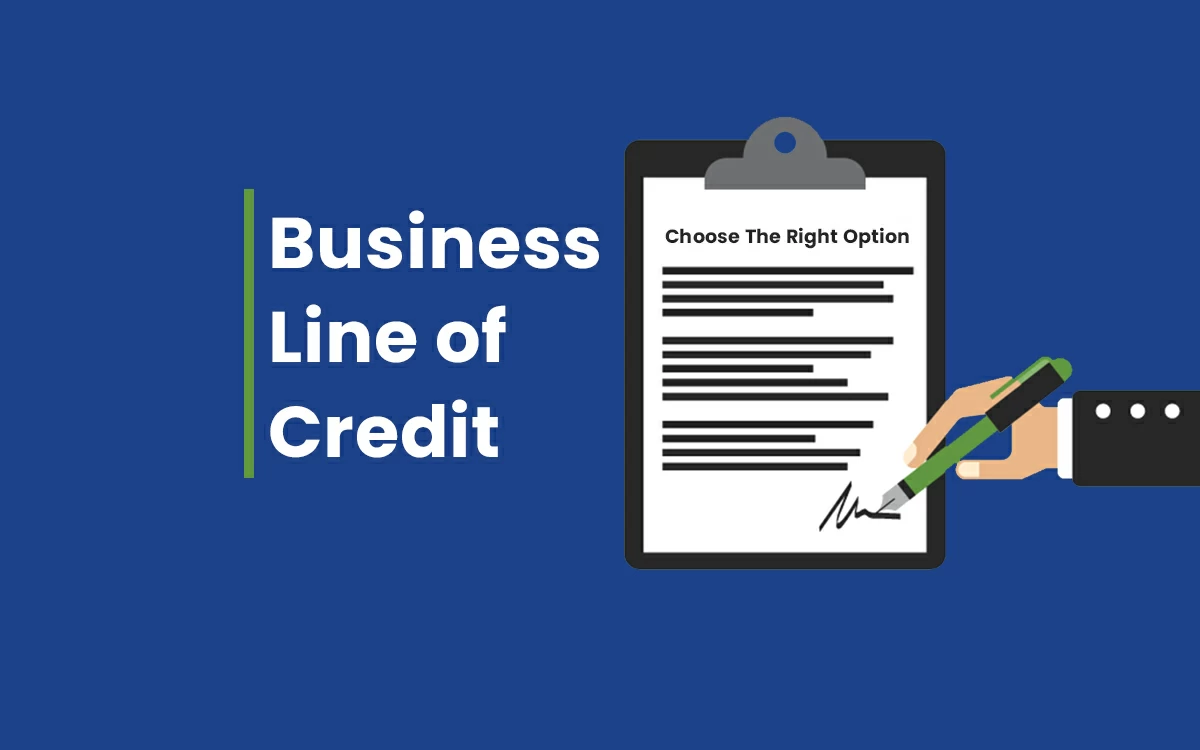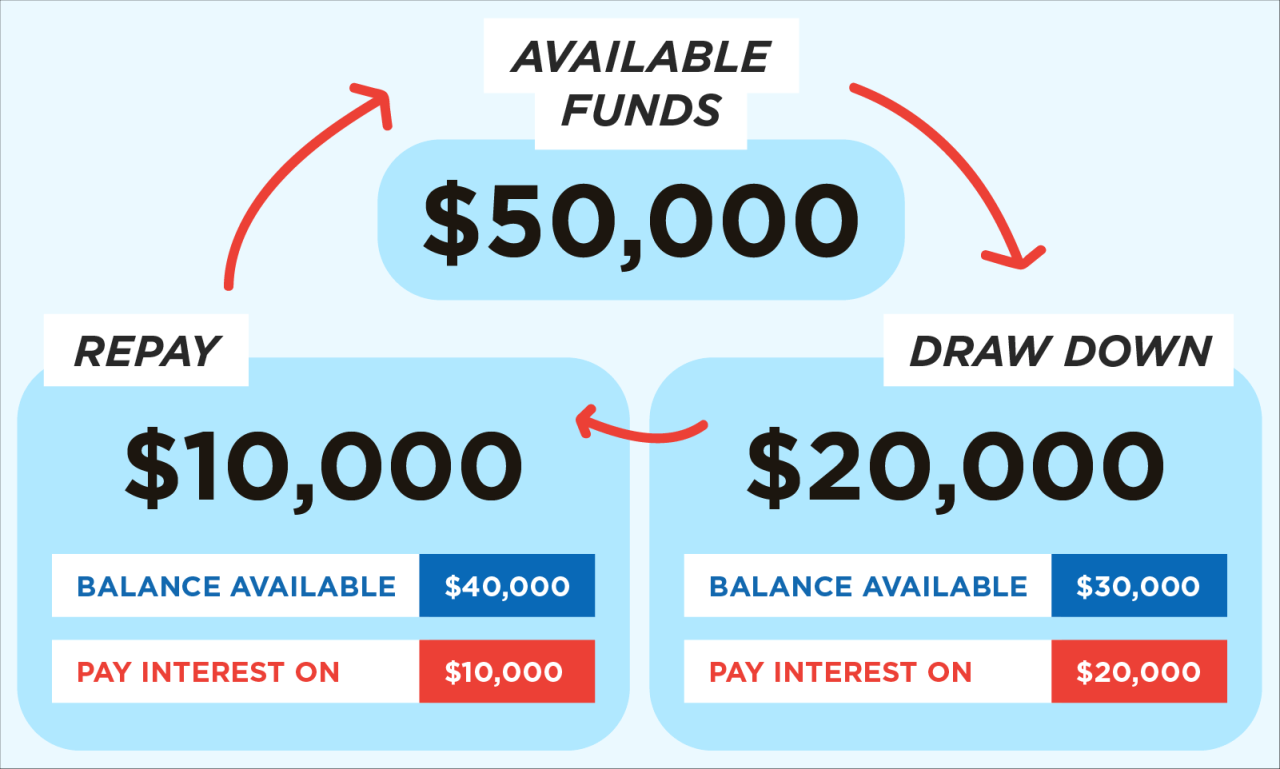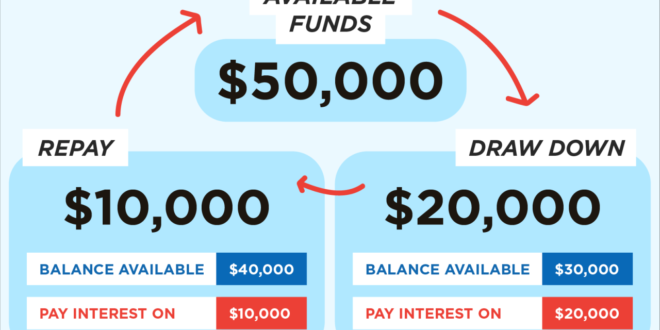Requirements for a business line of credit – Securing a business line of credit can be a powerful tool for managing cash flow and funding growth, but understanding the requirements is crucial. This guide will explore the key factors lenders consider when evaluating applications, including your credit history, business plan, and financial performance.
We’ll delve into the eligibility criteria, application process, and important considerations like interest rates and fees. By understanding these requirements, you can increase your chances of obtaining the financing you need to take your business to the next level.
Understanding Business Lines of Credit
A business line of credit is a flexible financing option that allows businesses to access funds as needed, similar to a credit card for businesses. It provides a pre-approved borrowing limit, enabling businesses to draw funds up to the limit and repay them over time.
Purpose and Function of a Business Line of Credit
A business line of credit serves as a revolving credit facility, providing businesses with access to funds for various operational needs, such as:
- Working Capital Management: Cover short-term expenses like payroll, inventory, and supplier payments.
- Seasonal Fluctuations: Manage cash flow during periods of increased demand or seasonal peaks.
- Unexpected Expenses: Address unforeseen costs like equipment repairs or emergency situations.
- Business Expansion: Fund growth initiatives, such as acquiring new equipment, hiring additional staff, or expanding operations.
- Marketing and Advertising: Finance marketing campaigns to boost sales and brand awareness.
Key Differences Between a Business Line of Credit and a Business Loan
A business line of credit differs significantly from a business loan in several key aspects:
- Repayment: A business line of credit allows businesses to draw funds as needed and repay only the amount borrowed, with interest charged on the outstanding balance. In contrast, a business loan involves a fixed amount borrowed, with regular payments made over a set term.
- Interest Rate: Interest rates on business lines of credit are typically variable, fluctuating with market conditions. Business loans usually have fixed interest rates, offering predictable monthly payments.
- Flexibility: Business lines of credit provide greater flexibility, allowing businesses to borrow funds only when required and pay them back as they generate revenue. Business loans offer a fixed amount of funds with a predetermined repayment schedule.
- Credit Limit: A business line of credit has a pre-approved borrowing limit, while a business loan provides a fixed amount of funds.
Benefits of Utilizing a Business Line of Credit
Utilizing a business line of credit offers several advantages for businesses:
- Flexibility: Access funds only when needed, reducing the risk of unused capital.
- Predictability: Variable interest rates offer predictability in monthly payments, based on market conditions.
- Improved Cash Flow: Manage cash flow effectively by borrowing funds during periods of high demand and repaying when revenue is strong.
- Access to Emergency Funds: Provide a safety net for unexpected expenses, ensuring business continuity.
- Building Credit History: Responsible use of a business line of credit can help build a positive credit history, making it easier to secure future financing.
Eligibility Requirements
Securing a business line of credit is a significant step for any company, and lenders carefully evaluate potential borrowers to ensure their financial stability and ability to repay the loan. Understanding the eligibility requirements is crucial for determining if a business line of credit is the right financing option.
Eligibility for a business line of credit is determined by various factors, including the business’s creditworthiness, financial history, and industry. Lenders consider these aspects to assess the risk associated with extending credit to a specific business.
General Eligibility Criteria
Lenders generally consider the following factors when assessing a business’s eligibility for a line of credit:
- Credit Score: A strong credit score demonstrates a history of responsible financial management. Lenders typically prefer businesses with a credit score of at least 680 or higher. This score reflects the business’s ability to repay debts on time and manage its finances effectively.
- Time in Business: Established businesses with a track record of profitability are considered less risky than new ventures. Lenders often require businesses to have been in operation for at least two years to be eligible for a line of credit.
- Revenue and Profitability: Consistent revenue and profitability demonstrate the business’s ability to generate income and cover its expenses. Lenders may require businesses to provide financial statements, such as income statements and balance sheets, to assess their financial performance.
- Debt-to-Equity Ratio: This ratio indicates the proportion of debt to equity financing used by the business. A lower debt-to-equity ratio suggests a healthier financial position and a lower risk for lenders.
- Collateral: Some lenders may require collateral, such as real estate or equipment, to secure the loan. This provides the lender with recourse in case of default. However, not all business lines of credit require collateral.
- Industry and Business Type: Lenders may have specific eligibility requirements based on the industry and business type. For example, businesses in high-risk industries may face stricter requirements or higher interest rates.
Credit Score and History
A strong credit score and history are essential for obtaining a business line of credit. A credit score reflects a business’s creditworthiness, indicating its ability to manage debt responsibly. A good credit score demonstrates a history of timely payments and responsible financial practices, which reassures lenders about the business’s ability to repay the loan.
To build a strong credit history, businesses should:
- Pay bills on time: Consistent on-time payments are crucial for establishing a positive credit history. Late payments can negatively impact a business’s credit score and make it more challenging to secure financing.
- Maintain a low debt-to-credit ratio: A low debt-to-credit ratio indicates that a business is not overextending its credit and can manage its debt effectively. Lenders prefer businesses with a low debt-to-credit ratio as it signifies a lower risk of default.
- Monitor credit reports regularly: Businesses should review their credit reports regularly to identify any errors or inaccuracies. Disputing any errors can help improve a business’s credit score and make it more attractive to lenders.
- Establish business credit: Separate business credit from personal credit to protect personal assets and build a strong business credit profile. This can be achieved by obtaining business credit cards, lines of credit, and loans in the business’s name.
Application Process

Applying for a business line of credit involves several steps, each designed to ensure the lender has a clear understanding of your business and its financial health.
Required Documentation
Lenders typically require specific documentation to evaluate your application. This documentation provides them with a comprehensive view of your business’s financial standing, revenue, and expenses.
- Business Plan: This document Artikels your business’s goals, strategies, and financial projections. A well-structured business plan is crucial for demonstrating your understanding of the market, your competitive edge, and your ability to manage your finances effectively.
- Financial Statements: These include your balance sheet, income statement, and cash flow statement. They provide a snapshot of your business’s financial position and performance over a specific period.
- Tax Returns: Recent tax returns, including both business and personal returns, help lenders assess your income and tax compliance history.
- Bank Statements: Bank statements for your business accounts demonstrate your transaction history and cash flow patterns.
- Credit Report: Your business credit report reflects your payment history and creditworthiness. Lenders use this information to assess your risk profile.
- Personal Financial Statements: In some cases, lenders may request personal financial statements, such as your personal balance sheet and income statement, to evaluate your overall financial standing.
Preparing a Compelling Business Plan
A well-crafted business plan is essential for securing a business line of credit. It should be clear, concise, and persuasive, effectively communicating your business’s value proposition, market opportunity, and financial projections.
“A business plan is not just a document; it’s a roadmap for your business’s success.”
- Executive Summary: Begin with a concise summary of your business, its goals, and its financial projections. This section should grab the lender’s attention and highlight the key points of your plan.
- Company Description: Provide a detailed overview of your business, including its history, products or services, target market, and competitive landscape.
- Management Team: Showcase the expertise and experience of your management team, demonstrating their ability to lead the business effectively.
- Marketing Plan: Describe your strategies for reaching your target market, promoting your products or services, and generating sales.
- Financial Projections: Present clear and realistic financial projections, including revenue, expenses, and cash flow forecasts. These projections should be based on sound assumptions and data.
- Funding Request: State the amount of funding you require and how you plan to use it to achieve your business goals.
Interest Rates and Fees

Understanding the interest rates and fees associated with a business line of credit is crucial for making informed financial decisions. These costs can significantly impact your overall borrowing expenses, so it’s essential to compare different lenders and their offerings.
Factors Influencing Interest Rates
Several factors influence the interest rate you’ll be charged on a business line of credit. These include:
- Your credit score: A higher credit score indicates a lower risk to lenders, resulting in a lower interest rate.
- Your business’s financial history: Lenders evaluate your business’s revenue, expenses, and cash flow to assess its financial health and ability to repay the loan. A strong financial history translates to a lower interest rate.
- The amount of credit you need: Larger loan amounts typically come with higher interest rates due to the increased risk for the lender.
- The length of the loan term: Longer loan terms generally result in higher interest rates, as lenders charge more for the extended period of risk.
- The current market interest rates: Interest rates on business lines of credit fluctuate based on prevailing market conditions. During periods of economic growth, interest rates tend to rise, while they may decrease during economic downturns.
- The lender’s policies: Different lenders have varying interest rate policies based on their risk appetite and business model.
Common Fees
In addition to interest rates, various fees can be associated with business lines of credit. These include:
- Annual fees: Some lenders charge an annual fee for maintaining the line of credit, regardless of usage.
- Transaction fees: These fees are charged for each withdrawal or transaction made using the line of credit. The specific fee structure can vary depending on the lender.
- Late payment penalties: Failure to make payments on time can result in late payment fees, which can significantly increase your borrowing costs.
Comparing Interest Rates and Fees
It’s essential to compare interest rates and fees from multiple lenders before choosing a business line of credit. Consider the following factors when comparing:
- Annual Percentage Rate (APR): The APR reflects the total cost of borrowing, including interest rates and fees.
- Fees: Compare the types and amounts of fees charged by different lenders, such as annual fees, transaction fees, and late payment penalties.
- Loan terms: Evaluate the loan terms, including the repayment period and any prepayment penalties.
- Customer service: Look for a lender with a reputation for excellent customer service and responsiveness.
Using a Business Line of Credit Effectively
A business line of credit can be a valuable tool for managing cash flow and funding growth, but it’s crucial to use it responsibly. Properly managing a line of credit can help you avoid unnecessary debt and interest charges, ensuring it works in your favor.
Managing Cash Flow and Minimizing Interest Expenses
Effective management of a business line of credit revolves around minimizing interest expenses and optimizing cash flow. Here are some key strategies:
- Pay off your balance regularly. The interest on a line of credit is typically calculated on the outstanding balance. By making regular payments, even small ones, you can reduce the amount of interest you accrue. This can significantly impact your overall borrowing costs.
- Use the line of credit strategically. Avoid using the line of credit for everyday expenses or short-term cash flow gaps. Instead, use it for specific business needs like seasonal inventory purchases, equipment upgrades, or short-term working capital needs. This approach helps minimize the amount you borrow and the interest you pay.
- Explore alternative financing options. If you have a long-term need for funds, consider other financing options like business loans or equity financing. These options may have lower interest rates than a line of credit, particularly for larger amounts.
- Monitor your credit utilization. High credit utilization can negatively impact your credit score. Try to keep your credit utilization ratio below 30%. This means using less than 30% of your available credit. Maintaining a good credit score can help you secure better interest rates on future loans and lines of credit.
Leveraging a Line of Credit for Growth and Expansion
A business line of credit can be a valuable tool for accelerating business growth and expansion. Here are some practical examples:
- Seasonal inventory purchases: Businesses with seasonal sales cycles often face fluctuating cash flow. A line of credit can provide the necessary funds to purchase inventory during peak seasons, ensuring adequate stock to meet demand.
- Marketing campaigns: Launching a major marketing campaign can require significant upfront investment. A line of credit can provide the necessary funds to cover marketing expenses, enabling you to reach a wider audience and drive sales.
- Equipment upgrades: Investing in new equipment or technology can enhance productivity and efficiency. A line of credit can help finance these upgrades, enabling you to stay competitive and expand your business capabilities.
- Expansion into new markets: Entering new markets often requires capital for initial setup costs, marketing, and inventory. A line of credit can provide the necessary funds to support your expansion efforts.
Alternatives to Business Lines of Credit

While business lines of credit offer flexibility and convenience, they might not be the ideal financing solution for every business. Several other financing options cater to different needs and circumstances. Understanding these alternatives allows you to choose the most suitable option for your business.
Business Loans
Business loans provide a lump sum of money that you repay over a fixed period with interest. They offer a predictable payment structure and can be used for various purposes, such as equipment purchases, renovations, or working capital.
- Term Loans: These loans have a fixed repayment period, typically ranging from 1 to 10 years. They offer a predictable payment schedule and are often used for major investments like equipment purchases or building renovations.
- SBA Loans: Backed by the Small Business Administration (SBA), these loans offer favorable terms, including lower interest rates and longer repayment periods. They are ideal for businesses with limited credit history or those seeking funding for specific purposes, such as expansion or working capital.
- Line of Credit Loans: Unlike traditional lines of credit, these loans provide a fixed amount of funding that you can access and repay over a set period. They offer a predictable payment schedule and can be used for various business needs.
Merchant Cash Advances, Requirements for a business line of credit
Merchant cash advances provide businesses with immediate funding in exchange for a percentage of future sales. They are typically used for short-term needs, such as covering seasonal expenses or bridging cash flow gaps.
- Pros: Quick approval and funding, no collateral required, suitable for businesses with consistent sales.
- Cons: High interest rates, can be expensive in the long run, repayment based on a percentage of sales can be unpredictable.
Equipment Financing
Equipment financing allows businesses to purchase equipment by making regular payments over a set period. This option is often used for acquiring expensive equipment, such as machinery, vehicles, or computers.
- Pros: Lower monthly payments than outright purchase, tax benefits, can be used for a variety of equipment.
- Cons: Interest rates can be high, may require a down payment, equipment becomes collateral for the loan.
Final Review: Requirements For A Business Line Of Credit
Navigating the world of business financing can be challenging, but with a clear understanding of the requirements for a business line of credit, you can make informed decisions that benefit your company. Remember to prepare a strong application, showcase your financial health, and explore various lenders to find the best fit for your specific needs.
User Queries
How long does it take to get approved for a business line of credit?
The approval process can vary depending on the lender and the complexity of your application. However, it typically takes a few days to a few weeks.
What are the typical interest rates for business lines of credit?
Interest rates are influenced by factors like your credit score, business history, and the amount of credit you request. Rates generally range from 5% to 15% or higher.
What are some tips for improving my chances of getting approved for a business line of credit?
Build a strong credit history, maintain a good credit score, prepare a comprehensive business plan, and demonstrate a solid track record of financial performance.
 Norfolk Publications Publications ORG in Norfolk!
Norfolk Publications Publications ORG in Norfolk!

